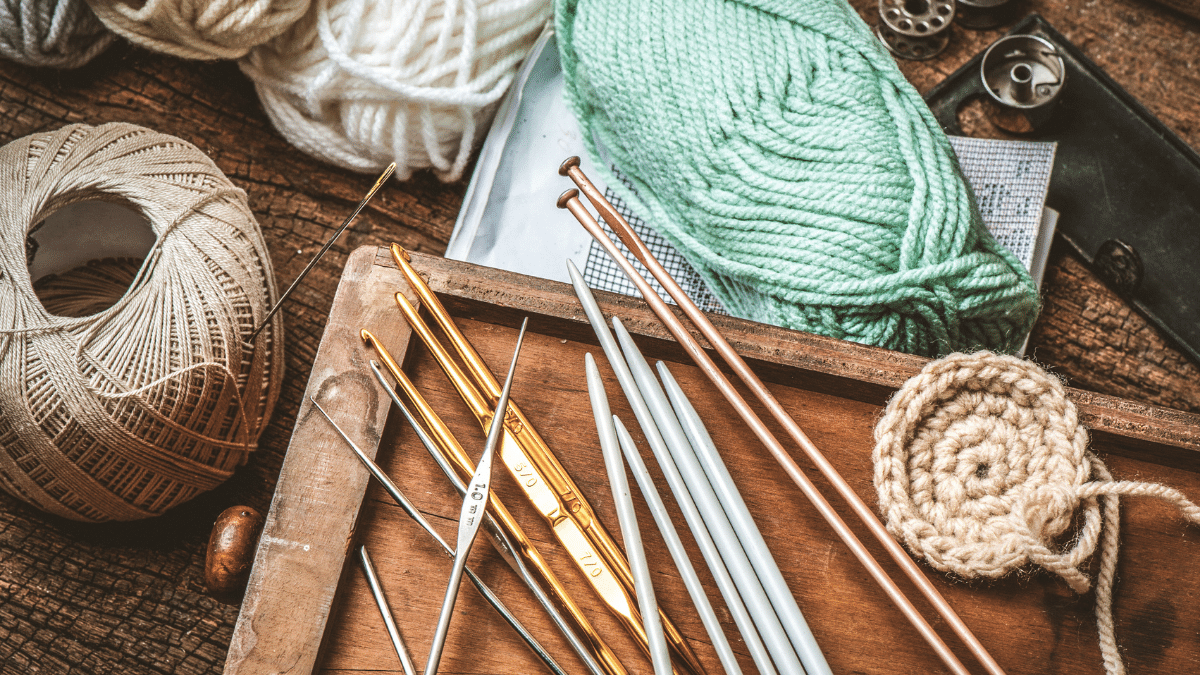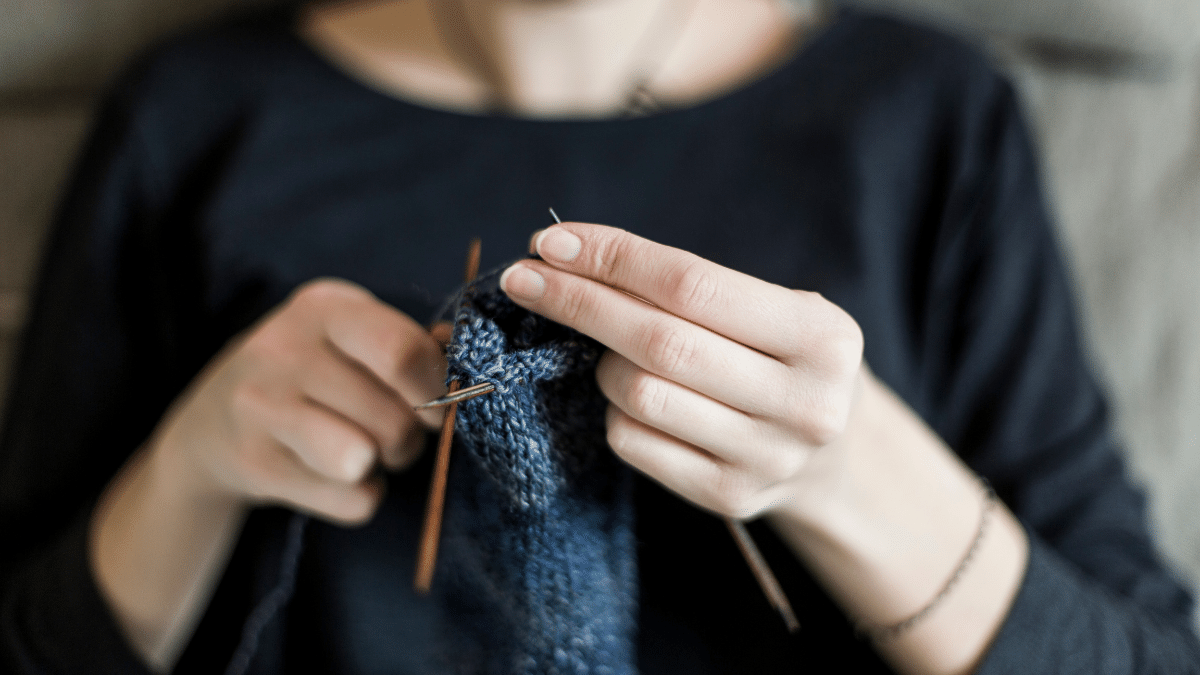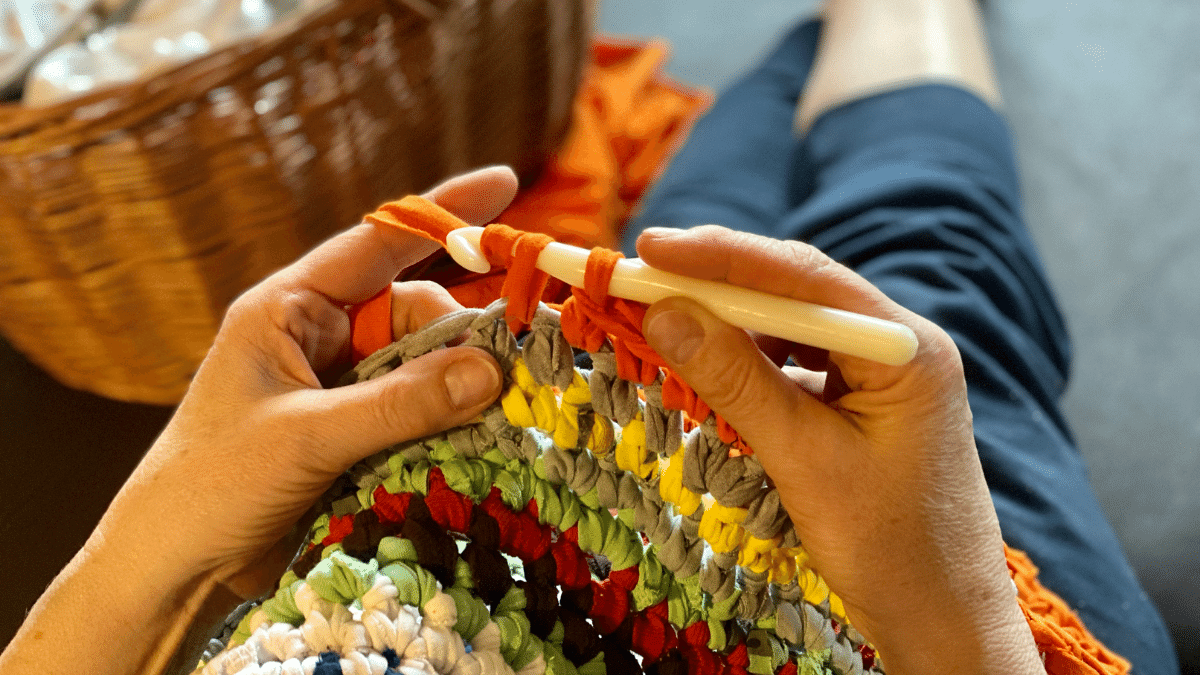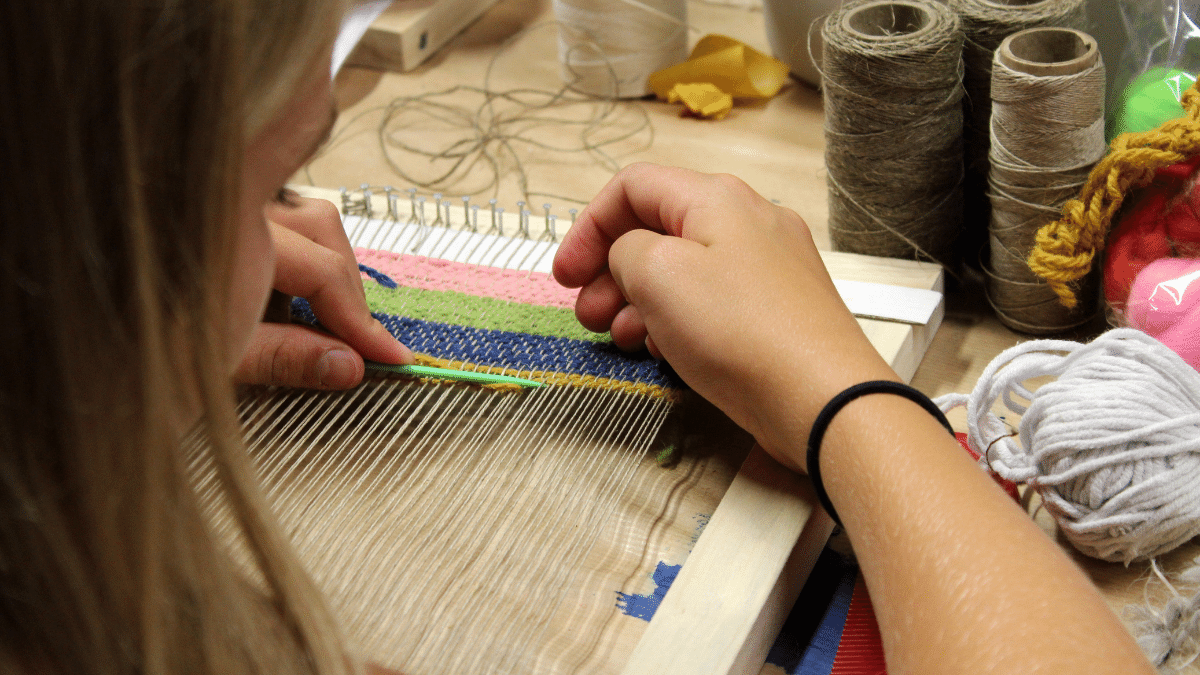
We all know someone who’s a dab hand at knitting, crochet, and weaving. They’re all fantastic at making clothes, bedding, and even toys and comforters. What’s more, they are all fantastically relaxing hobbies to turn to from time to time.
Since all three of these methods revolve around creating patterns out of fabrics, many people believe that they are interchangeable – wrong!
So, what is the difference between knitting vs crochet vs weaving, anyway?
The short answer is that knitting uses two different needles; weaving uses two different types of fabric, and crochet only uses one needle, a yarn strand, and loops.
That sounds simple enough – but, as you might expect, there’s more to these differences than meets the eye. Let’s crack on with what you can expect from your potential new hobby, and which form fits you best!
What is knitting?

Many of us can envisage our grandparents gearing up with two wooden needles, making scarves, socks or even toys out of large balls of yarn. In fact, the word ‘knit’ derives from ‘cnyttan’, an old English word meaning to tie a knot!
But, there’s more to knitting than just tying knots – technically, that can apply to crochet, too. Confused yet? Don’t worry!
First of all, it is important to remember that knitting involves the creation of stitches. Stitches are loops of yarn that intertwine to make solid fabrics.
There are multiple types of stitch that can be used during a knit, although the two most commonly relied-upon are the pearl stitch and the general knit stitch.
Knitting only involves one strand of yarn, whether it is from a large ball or just one piece.
What’s more, knitting needles come in a wide variety of sizes and materials. In fact, a good knitter will choose their tools based on what they’re making – and their own preferences.
You can even buy rounded knitting needles, for example – these are usually used to create circular fabrics and even tubes.
It’s also possible to knit via loom – which is where there’s some similarity with weaving. However, knitting and weaving looms are two different tools.
Knitting looms are used by those who do not want to put as much stress on their hands during the act, and can help to create uniform patterns, shapes, styles, and looks.
Of course, knitting machines also remain popular, mainly thanks to their efficiency over using looms or relying on your hands.
You can find knitting machines that are either semi or fully automated – and while that does save time and effort, most passionate knitters prefer using their own hands.
After all, if you want to do things ‘properly’, many would argue grabbing a couple of needles and getting stuck in is the best route to travel!
Did you also know that you can knit with just your hands? It’s never recommended for beginners, but if you’re feeling brave, you can leave the needles to one side and get stuck in with your fingers.
This can lead to larger, more simplistic patterns than you’d expect with traditional knitting, so save it for easier projects.
You can usually tell if a fabric has been knitted by how many strands have been used (if you can tell for one set piece). However, it is important to remember that unique pieces can be attached to one another to create larger ones (as is often the case in scarves, blankets, and quilts).
You can also tell that something has been knitted by the fabric used – yarn – and its ridged texture.
What is crocheting?

Crocheting is a little more difficult to define, as it does resemble knitting quite a lot – but, the main differences lie in the tools you’ll need.
Like knitting, crocheting involves creating unique fabrics from one strand of yarn that has been intertwined with itself to form loops.
The differences boil down to your trusty crochet hook, the heart of this crafting operation. In fact, the word crochet actually comes from the French word ‘croche’, which means hook!
A crochet hook resembles a knitting needle in that it is fairly long, and however thick you need it to be depending on your project. However, the end is curved into the shape of a hook – hence the name. And, unlike in knitting, for crocheting, you only need one hook to create a piece.
Most crochet hooks are made from aluminum. However, again, just like knitting needles, crochet hooks can arrive in different materials and in various sizes, too. Everything depends on what you are making and your own personal crafting preferences.
You’ll need to start any crochet piece with a chain stitch. From there, you can pretty much make any combination of stitches that you like.
It can be a little difficult to determine whether a fabric has been knit or crocheted.
Apart from the initial chain stitch, crocheting doesn’t have one set stitch or pattern that can be recognized above others.
The only slight difference that you might notice is that crochet stitches tend to be more akin to knots. However, it would take a trained eye to notice, and even then, it could have been knitted! Even trained eyes have difficulty telling between pieces.
However, it stands to reason that you probably have more crocheted items in your home than you might realize. Items such as covers, blankets, hats, and scarves are often crocheted.
Little yarn pieces that are added onto clothes, blankets, hair pieces, and more (such as brooches, pockets, and intricate details) are usually crocheted, too.
Crocheted items are generally less flexible than knitted projects. That’s largely because crocheted items are usually very tightly made, as the loops holding the patterns together are smaller and more intricate than knitted projects.
Of course, this isn’t always the case, and a lot depends on the fabric, the person doing it, and the stitches that have been made.
In any case, crocheting and knitting carry a lot of similarities – though, it pays to know the difference depending on the project you’d like to get started with!
Crochet tends to be popular with people who want to make specific shapes that might otherwise be hard to knit or weave. For example, it’s easy enough to learn how to crochet your own circles and ovals.
It’ll take a little bit of practice, but the practical and creative freedom you’ll get from crochet really can’t be beat.
Many people find crochet easier than knitting and vice-versa. My advice would be to give either option a try and to see how you feel – you’ll produce very similar results through either method, so keep an open mind! Weaving, on the other hand, is a different matter!
What is weaving?

Magnificent weaving machines, or looms, are amazing to watch in practice – but, with a little bit of practice and some time dedication, you’ll be able to create some masterpieces you can be proud of.
Simply put, weaving is the process of taking two pieces of yarn and crossing them over each other. One strand needs to be vertical (known as the warp), and one needs to be horizontal (known as the weft).
Many people are familiar with the process of plain weaving, in which the weft goes under and over every other warp.
What many people don’t know, however, is that there are many different styles of weaving and even different types of looms!
Many of us can picture basic picture frame looms, but there are also table looms, frame looms, floor looms, and even rigid heddle looms.
Each one has an intricate setup and operation, thus creating different forms of weaving. If you’re keen to get into weaving, it’s certainly worth researching different types of loom available!
But, how do you recognize whether or not a fabric has been woven? It’s actually pretty simple. Just closely examine the pattern and see if it looks like a grid.
If you see one section of the fabric going one way, and passing over the other fabric which is going in the opposite direction, you’re handling woven material.
Many of us have items in our homes that have been woven, from our clothes and furniture covers to our bedding and even handkerchiefs!
For example, one easy woven pattern to identify easily is the one on a simple pair of jeans. When you look at your own jeans closely, you should be able to see two different sets of lines crossing over each other in vertical and horizontal directions.
If you cannot see them, then magnify them with a glass – or your phone’s camera – and you’ll soon see what I mean!
Weaving doesn’t always have to be exclusive to fabric-making, either. Think of baskets, pots made from leaves, straw hats, and more! These have all been woven very carefully using different materials that cross over one another in set patterns.
Tapestries that we keep on our walls have all been woven, too. However, tapestries are known for using discontinuous weft. This is so that the fabric can show a particular image to create artwork.
This kind of weaving does not serve a functional purpose but rather an artistic one – it’s known as non-functional weaving.
Of course, the weaving that we use on our clothes, pots, and so on is known as functional weaving, as it serves a purpose. Simple!
Believe it or not, weaving is also the oldest form of creating fabric, by a long way. In fact, weaving has been around for thousands of years! It is believed that people started weaving around the Neolithic period.
What are the main differences between knitting, crocheting, and weaving?
Crochet, weaving, knitting – they’re all great ways of bringing unique fabrics to life. But, as you’ve noticed, there are a few key differences.
First of all, look at the fabrics used. While weaving can involve any kind of fabric and even different kinds of materials (such as wood and leaves), both crocheting and knitting involve the use of yarn.
Of course, yarn arrives in different sizes, lengths, and colors, but it remains easy to identify.
Secondly, take a look at the stitching techniques. Woven material goes over and under itself, whereas knitting and crocheting usually involve creating different kinds of knots.
Again, patterns can be different, but they do not cross over each other as they do in woven fabrics.
All kinds of weaving also involve at least two sets of strands. There needs to be one set going downwards and one across. This makes the criss-cross pattern that we can easily identify.
On the other hand, knitted and crocheted patterns are made using just one piece of yarn. The completed stitch can then be added to another to create a large fabric, but each individual pattern is made using only one strand of yarn.
Finally, the tools used are the main way of discerning whether a pattern has been knit, crocheted or woven. If the fabric was created using hooks, then it was crocheted. If it was made using knitting needles, machines, looms, or by hand, then it was knit.
However, if the pattern was made using a weaving loom, or by crossing different strands of material by hand, then it was woven.
You could also look at the origins of each of these methods to distinguish them from one another, but visually, all you really have to go on are the differences mentioned above!
Which should I try first – crocheting, knitting or weaving?
Far be it from me to tell you which fabric-making hobby is ‘the best’! As you’ve seen from the guide above, you can knit, weave and crochet all kinds of different designs and materials.
I’d advise you to take a look at different projects you can bring to life and then choose your weapon!
Crocheting tends to be a popular choice among those creatives who want to create intricate shapes and characters, such as those they can bring to life in the shape of dolls.
Knitting is a great option for those of us who enjoy making our own clothes and accessories, while weaving is superb for making all kinds of bits and pieces.
Weaving actually tends to be a good choice for making practical and non-functional items, meaning if you have your heart set on a wide range of crafts, it might be worth learning this craft as a priority!
It’s a common misconception that one style of fabric work is more difficult than another. They all require a steady hand and a creative spirit – and while some may tell you that crocheting is perhaps the hardest of all, you never know what you might find easy to get into.
I’d suggest taking a look at a few ideas across social media such as Pinterest, where you’ll find collections of crochet, knitting and weaving projects and patterns you can work your way up to.
Conclusion
Knitting, crocheting, and weaving are all popular ways of creating patterns, clothes, and gifts – they’re never likely to go out of fashion! Although they each have their own styles and require a lot of work, the main difference lies in the tools of the trade.
What’s more, everyone has a preference – there’s no ‘perfect’ way to create fabrics! Although their end patterns may be similar (especially when it comes to knitting and crocheting), it’s how you get there that matters.
Once you get the hang of your chosen craft, there is nothing quite as relaxing or indeed as rewarding as finishing your own piece, whether it was woven, knit, or crocheted.
These kinds of handmade fabrics and items also make for fantastic gifts and even family heirlooms.
Take it slowly – you can’t expect to make masterpieces in a day! What you can do, however, is brush up on your crocheting skills, for example, by taking a closer look at other guides I have available.
Grab the right tools, and who knows what you could make?
Originally posted 2022-08-12 10:42:14.
